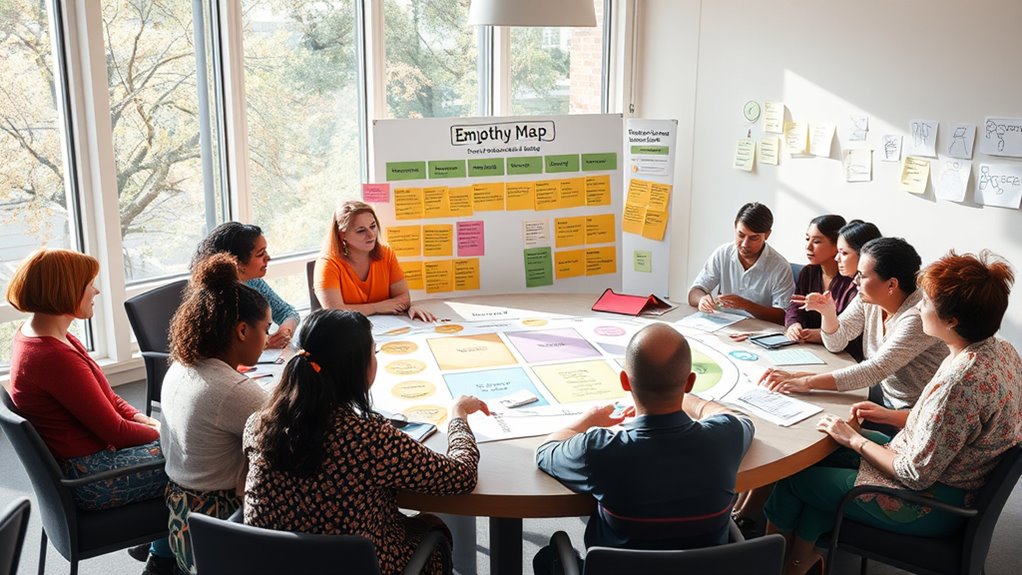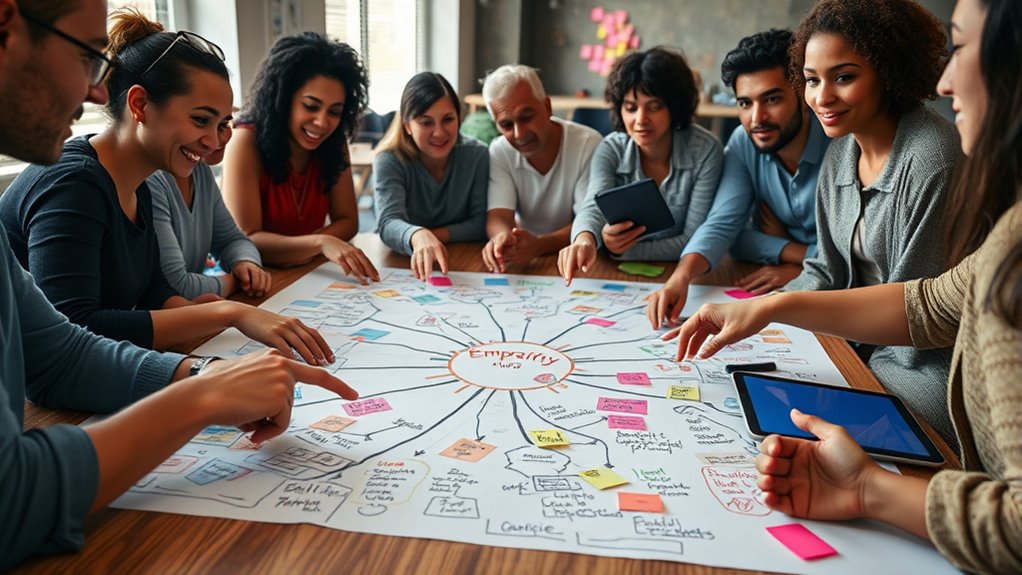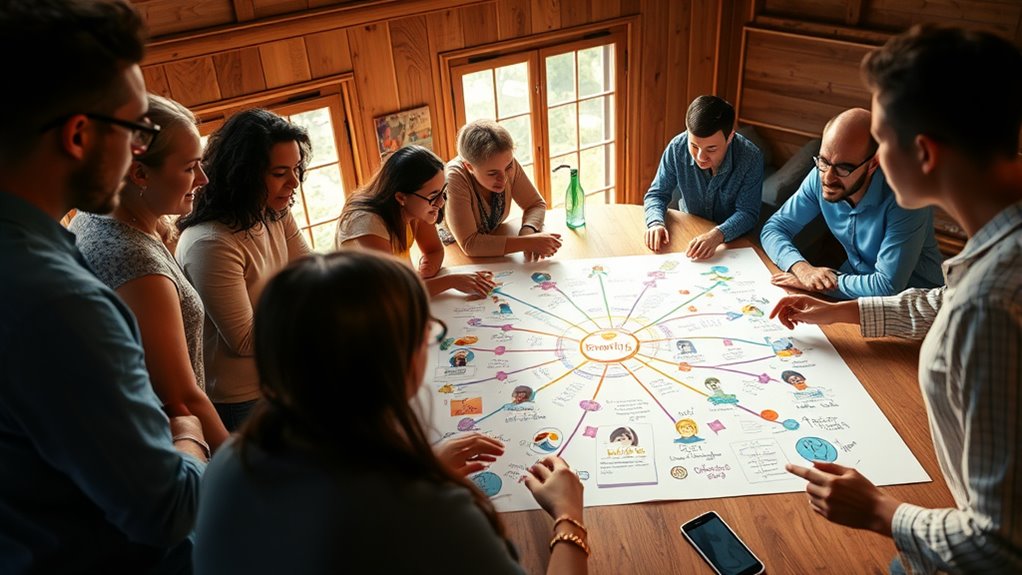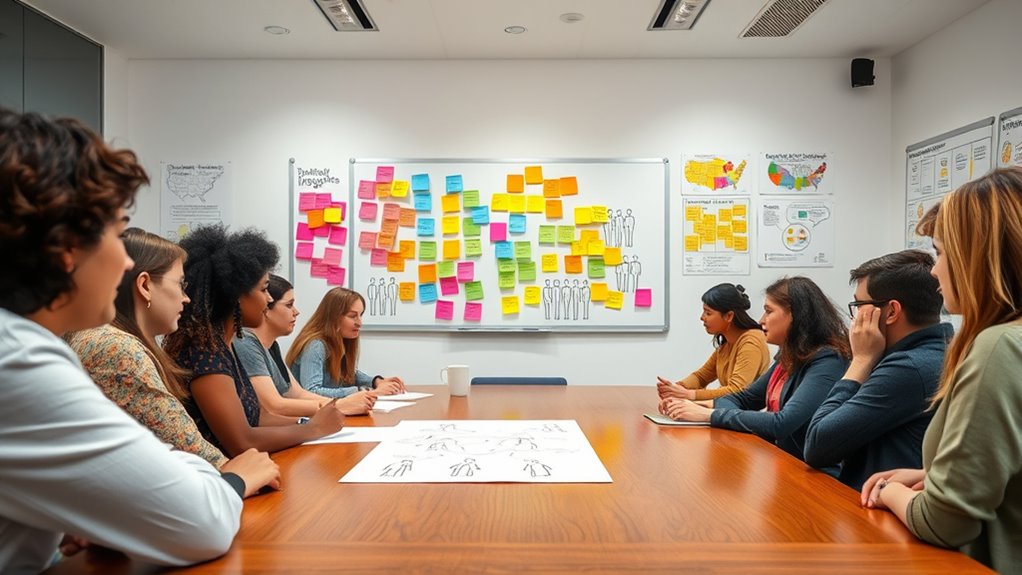Empathy mapping is a powerful tool that helps you understand the thoughts, feelings, and needs of your target community, which often go unspoken. By capturing emotional insights and stakeholder perspectives, you can design social programs that truly resonate and address real challenges. It promotes better communication, builds trust, and guides you in creating tailored, community-centered initiatives. Exploring this approach further can open more effective strategies for your social efforts.
Key Takeaways
- Empathy mapping uncovers stakeholders’ thoughts, feelings, and needs, guiding the development of more targeted and effective social programs.
- It captures emotional drivers and unspoken concerns, ensuring programs resonate deeply with community members.
- Incorporating cultural and behavioral insights through empathy mapping enhances program relevance and acceptance.
- It promotes stakeholder collaboration and shared understanding, improving communication and trust in program design.
- Empathy mapping facilitates early identification of gaps and challenges, leading to more sustainable and community-centered solutions.
Understanding Empathy Mapping and Its Significance

Understanding empathy mapping is essential because it helps you gain deeper insights into your users’ thoughts, feelings, and behaviors. By capturing emotional insights, you can better understand what motivates or challenges your users, leading to more meaningful user experiences. This process allows you to see your users from their perspective, uncovering unspoken needs and frustrations that might not be immediately obvious. When you focus on these emotional insights, you’re equipped to design social programs that genuinely resonate with your audience. Incorporating cultural intelligence from related fields can help tailor programs that support overall well-being. Additionally, understanding nutritional value and preferences can inform more effective engagement strategies. Recognizing behavioral patterns can further enhance your ability to address specific community needs. Ultimately, it transforms raw information into actionable understanding, making your efforts more effective and user-centered.
Components of an Effective Empathy Map

An effective empathy map is built around a few key components that help you capture an all-encompassing picture of your users’ experiences. These components include understanding their thoughts, feelings, needs, and behaviors. Incorporating stakeholder analysis ensures you consider all relevant perspectives, enriching your persona development. To illustrate, here’s a simple breakdown:
| Segment | Focus | Purpose |
|---|---|---|
| Think & Feel | What users are thinking and feeling deeply | Uncover emotional drivers and concerns |
| Hear & Say | What users hear from others and say about their experience | Understand communication influences |
| See & Do | Visual environment and actions taken | Recognize environmental impacts and behaviors |
Understanding the horsepower of electric dirt bikes can provide insights into the performance expectations of potential users, which is vital for designing programs that meet their needs. Additionally, considering anime movies and their storytelling techniques can inspire more empathetic program design by understanding diverse narratives and emotional appeals. These components enable you to develop nuanced personas and craft targeted social programs, especially when considering factors like projector image quality and how they influence user engagement in various settings. Furthermore, integrating water-related recreational activities can help tailor programs that promote community well-being and active lifestyles.
Step-by-Step Guide to Creating an Empathy Map

Creating an empathy map involves a clear, step-by-step process that guides you through capturing your users’ perspectives effectively. Begin by engaging stakeholders early, ensuring their insights reflect cultural sensitivity. Start with defining the user or community you’re focusing on, then gather data through interviews, observations, or surveys. Map out what they say, think, do, and feel, paying attention to cultural nuances that influence their experiences. Use stakeholder engagement to validate your findings and deepen understanding. Keep the process collaborative, encouraging diverse voices to contribute. Be mindful of cultural differences to avoid assumptions and biases. Recognizing the importance of emotional alignment can help you better understand how individuals interact with their environment. Incorporating raw nutrition concepts can provide additional context for understanding health-related behaviors within communities. Being aware of cultural sensitivity ensures that your approach respects and incorporates community values, fostering more effective engagement. Additionally, understanding credit card insights can inform how economic factors influence community behaviors and decision-making. This structured approach helps you develop a holistic view of your users, setting a strong foundation for designing impactful social programs.
Integrating Empathy Mapping Into Program Design

Integrating empathy mapping into program design transforms insights about users into actionable strategies that directly address their needs. You can enhance stakeholder engagement by presenting empathy maps through clear data visualization, making complex user experiences easier to understand. Use visual tools like charts or diagrams to highlight key pain points, motivations, and preferences, ensuring everyone involved sees the same insights. This shared understanding fosters collaborative decision-making and aligns team efforts around user-centered goals. Incorporating empathy maps early in the design process helps you identify gaps and opportunities more effectively. By translating empathy insights into visual formats, you make user perspectives tangible, facilitating informed decision-making and more targeted social programs that truly resonate with your community’s needs. Additionally, employing mindfulness techniques can help team members remain present and empathetic throughout the planning process, fostering deeper understanding and connection. Recognizing the importance of community involvement ensures that program designs are rooted in real user experiences and needs, leading to more effective interventions. Self Watering Plant Pots can serve as an analogy for designing programs that maintain consistent support for community members over time.
Real-World Examples of Impactful Social Programs Using Empathy Maps

Empathy mapping has proven to be a powerful tool in shaping successful social programs, as seen in several real-world examples. It enhances community engagement and deepens stakeholder analysis, leading to better tailored initiatives. Here are four impactful cases:
- A youth outreach program used empathy maps to understand teens’ motivations, boosting engagement and participation.
- A healthcare project applied stakeholder analysis through empathy maps to address diverse patient needs, improving service delivery.
- An urban renewal effort incorporated community insights, fostering trust and collaboration.
- A homelessness initiative identified barriers via empathy maps, leading to targeted support services.
- Understanding community-specific themes ensures that community-driven programs respect individual rights and build trust with stakeholders. Additionally, incorporating stakeholder analysis helps identify key community concerns and priorities more effectively. Recognizing the importance of effective communication within empathy mapping processes further enhances stakeholder relationships and program success.
These examples show how empathy mapping aligns stakeholder perspectives with community needs, resulting in more effective, empathetic social programs.
Frequently Asked Questions
How Can Empathy Mapping Be Adapted for Diverse Populations?
To adapt empathy mapping for diverse populations, you should prioritize cultural sensitivity and language adaptation. You’ll need to respect different cultural norms, values, and communication styles, ensuring your mapping process is inclusive. Use native languages or culturally relevant terminologies, and involve community members in the process. This approach helps gather authentic insights, making your social programs more effective and responsive to the unique needs of each population.
What Are Common Pitfalls to Avoid When Creating Empathy Maps?
Ever wonder what mistakes can derail your empathy map? Avoid confirmation bias by seeking diverse perspectives, and steer clear of oversimplification that risks missing nuanced insights. Do you really understand your target group’s complex experiences? If not, your map may lead to misguided assumptions. Stay open-minded, question your biases, and incorporate varied voices to create a more accurate, effective understanding of those you aim to serve.
How Often Should an Empathy Map Be Updated During Program Development?
You should update your empathy map regularly during program development to reflect new insights and stakeholder feedback. The frequency of updates depends on the project’s complexity and progress; generally, revisiting it every few weeks or after key milestones works well. Keep stakeholders involved in these updates to make certain the map stays accurate and relevant, helping you better understand your audience’s evolving needs and improve your social program accordingly.
Can Empathy Mapping Be Used for Virtual or Remote Community Analysis?
Imagine connecting with a community across screens instead of streets. You can absolutely use empathy mapping for virtual engagement, capturing remote insights effectively. It helps you understand diverse perspectives, even from afar. By leveraging online tools and interactive methods, you gain deeper empathy, fostering meaningful connections despite physical distance. This approach transforms remote interactions into powerful insights, making your social programs more inclusive, responsive, and impactful, no matter where your community members are located.
What Tools or Software Facilitate Effective Empathy Mapping Processes?
You can use various digital tools and collaborative software to facilitate effective empathy mapping. Platforms like Miro, MURAL, and Google Jamboard allow you to create interactive, shared spaces where team members can contribute and visualize insights in real-time. These digital tools make remote collaboration seamless, helping you gather diverse perspectives, understand user needs better, and ultimately design more impactful social programs.
Conclusion
By using empathy mapping, you can better understand the people your social programs serve. When you step into their shoes, you create more effective, impactful solutions. Did you know that programs built around empathy see up to 30% higher success rates? So, embrace this powerful tool, and watch your initiatives truly resonate with those who need them most. Your understanding can make all the difference in creating meaningful change.









